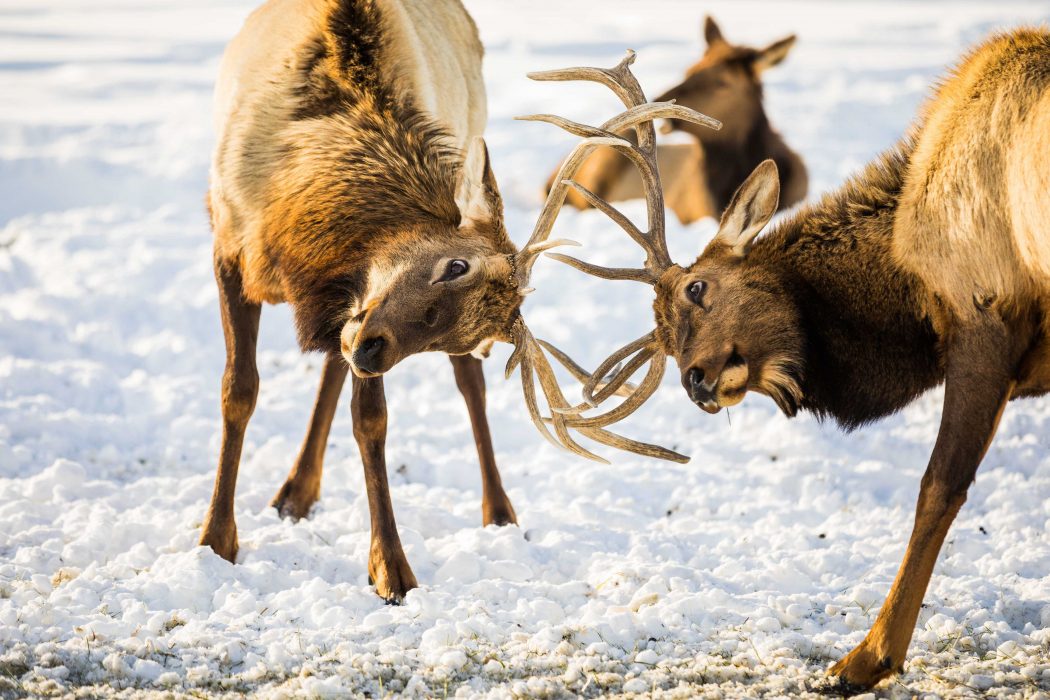Diseased elk might cause disaster in Cache Valley
It all started with the cattle. Then the bison. Then the elk. Now the cattle have it again.
With each spontaneously aborted fetus, wild elk are bringing the bacterial disease known as brucellosis closer to dairy farms in Utah. And the spread of the disease in Cache Valley could now hinge on what is happening at a state-run elk feeding ground.
Hardware Ranch manager Brad Hunt believes “it’s not an if, but rather a when it will show up,” at his Hyrum facility. But some local agriculturalists are worried the ranch itself may be what draws brucellosis to Utah.
For dairy farmers, the effect could be disastrous.
“It is a horrible disease. It is one of the worst diseases that is spread by wildlife,” said Johan du Toit, a professor of wildland resources at Utah State University who published research with graduate student Gavin Cotterill in October on the disease’s spread through elk in Yellowstone.
Brucellosis, originally found in cattle, is a bacteria that affects reproductive organs and causes pregnant females to abort spontaneously.
It was rampant in the early 20th century and, according to the U.S. Department of Agriculture, cost dairy and beef producers more than $400 million in 1952.
Brucellosis was almost eradicated except in the Yellowstone region, said Jamie Jonker, the vice president of sustainability and scientific outreach for the Milk Producers Federation of America.
Now elk are spreading it across the Intermountain West.
In wild elk herds, “it is now out of control,” du Toit said.
Brucellosis often spreads between elk in feedgrounds, where they are fed in the winter to prevent negative human interactions. All 23 feedgrounds in Wyoming have tested positively for brucellosis.
There is only one feedground in Utah, however. Hardware Ranch has been feeding elk herds in the winter since 1946. The ranch even hosts sleigh rides through the herd.
Forty female elk are tested for brucellosis each year, Hunt said, and so far all tests have been negative. Hardware Ranch has also outfitted some of its elk with GPS collars, and while most stay out of the greater Yellowstone ecosystem, Hunt said there are some elk they have tracked into areas where brucellosis has been found.
Brucellosis can spread easily to beef and dairy cattle. Jonker said it has so far been well-controlled and has only resurfaced in a few cattle herds near Yellowstone National Park.
If humans consume unpasteurized milk from infected cows, they can contract the disease, Jonker said. In humans the disease is known as undulant fever, and symptoms are similar to influenza, but often keep returning without treatment.
According to the Centers for Disease Control, 115 people were diagnosed with undulant fever in 2010 — the latest year with available data.
Mitigating these risks requires a stringent response.
“If brucellosis is found in a herd, the herd is either entirely slaughtered or limited in movement and sales,” Jonker said, and this could ruin producers economically.
Feedgrounds can help prevent such outcomes by keeping the elk herds away from the valley, du Toit said.
But, he said, “the managers of the feedgrounds are caught in the horns of a dilemma. On one hand, the feedgrounds have created a problem. But they must be maintained to contain the problem.”
Hunt said when an elk is found to have the disease at Hardware, that is when the continuation of feeding in Utah will be evaluated more seriously.
In order to see how elk are affected by shutting down feeding, Hunt said Hardware will stop feeding a month earlier than before.
Du Toit said it is very likely elk will bring the disease to Utah in the near future, and when they do, cows could get infected. For producers in agriculture-based community like Cache Valley, he said, “it would be economic disaster.”
Jonker said there has not been a case of brucellosis in dairy cattle for about 10 years, but if elk coming to Utah are mingling with infected herds, that could change quickly.
Either way, du Toit said, “It won’t be long before Utah joins Idaho, Wyoming and Montana as a brucellosis state.”
carter.moore@aggiemail.usu.edu
@carterthegrreat

